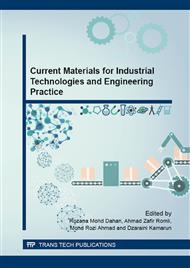[1]
J. Rivera-Utrilla, M. Sánchez-Polo, V. Gómez-Serrano, M.P. Alvarez, M.C. M Alvim-Ferraz, M.J. Dias. Activated carbon modifications to enhance its water treatment applications. An overview. Journal of hazardous materials, 2011; 187, 1-23.
DOI: 10.1016/j.jhazmat.2011.01.033
Google Scholar
[2]
M.R. Bhise, A.A. Patil, R.A. Raskar, J.P. Patil, P.D. Deshpand. Removal of Colour of Spent Wash by Activated Charcoal Adsorption and Electrocoagulation. Research Journal of Recent Sciences, 2012; 1, 66-69.
Google Scholar
[3]
S.G. Zhang, H. J. Qu, J. H. Liu, T. A. Cooper, C. R. Wu. CuFe2O4/activated carbon composite: A novel magnetic adsorbent for the removal of acid orange II and catalytic regeneration. Chemosphere, 2007a ; 68, 1058–1066.
DOI: 10.1016/j.chemosphere.2007.01.081
Google Scholar
[4]
H. Cui, Y. Cao, P. W. Pan. Preparation of activated carbon for mercury capture from chicken waste and coal. Journal of analytical and applied pyrolysis, 2007; 80(2), 319-324.
DOI: 10.1016/j.jaap.2007.04.002
Google Scholar
[5]
H.B. Hameed, M. A. Din, L.A. Ahmad. Adsorption of methylene blue onto bamboo-based activated carbon: kinetics and equilibrium studies. Journal of hazardous materials, 2007; 141(3), 819-825.
DOI: 10.1016/j.jhazmat.2006.07.049
Google Scholar
[6]
T.J. Nwabanne, K.P. Igbokwe. Preparation of activated carbon from Nipa palm nut: Influence of preparation conditions. Research Journal of Chemical Sciences, 2011; 1, 53-58.
Google Scholar
[7]
M. J. Salman., &, H. B. Hameed. Adsorption of 2, 4-dichlorophenoxyacetic acid and carbofuran pesticides onto granular activated carbon. Desalination, 2010; 256(1), 129-135.
DOI: 10.1016/j.desal.2010.02.002
Google Scholar
[8]
P. R. Bansal. And M, Goyal. Activated Carbon Adsorption, CRC Press, Taylor & Francis Group, 6000 Broken Sound Parkway NW, Suite 300 Boca Raton, FL, USA 2005; 33487-2742.
DOI: 10.1017/s0001924000007041
Google Scholar
[9]
M.J. Dias, M. Alvim-Ferraz, F.M. Almeida, J Rivera-Utrilla, M. Sánchez-Polo. Waste materials for activated carbon preparation and its use in aqueous-phase treatment: a review. Journal of Environmental Management, 2007; 85, 833-846.
DOI: 10.1016/j.jenvman.2007.07.031
Google Scholar
[10]
S. Babel, A. T. Kurniawan. Low-cost adsorbents for heavy metals uptake from contaminated water: a review. J Hazardous Mat, 2003; 97, 219–243.
DOI: 10.1016/s0304-3894(02)00263-7
Google Scholar
[11]
A. C. Başar. Applicability of the various adsorption models of three dyes adsorption onto activated carbon prepared waste apricot. Journal of Hazardous Materials, 2006; 135(1), 232-241.
DOI: 10.1016/j.jhazmat.2005.11.055
Google Scholar
[12]
W. I. A. Tan, L. A. Ahmad, &,H. B. Hameed. Adsorption of basic dye on high-surface-area activated carbon prepared from coconut husk: Equilibrium, kinetic and thermodynamic studies. Journal of Hazardous Materials, 2008; 154(1), 337-346.
DOI: 10.1016/j.jhazmat.2007.10.031
Google Scholar
[13]
T. Leiknes., &, H. Odegaard. Moving bed biofilm membrane reactor (MBB-MR): characteristics and potentials of a hybrid process design for compact wastewater treatment plants. In Proceedings of Engineering with Membranes, 2001; 1, 52-57.
Google Scholar
[14]
Paker management technology. BioFilm product catalogue. Technology Sdu Bhd, (2005).
Google Scholar
[15]
K. Shahot, &, A. Ekhmaj. Evaluation Biofilm Sewage Treatment Plant. In Proceedings of World Academy of Science, Engineering and Technology. World Academy of Science, Engineering and Technology, 2012; 6(12), 16-19.
Google Scholar
[16]
K. Shahot, A. Idris, R. Omar, M.H. Yusoff. . Review on Biofilm Processes for Wastewater Treatment. Life Science Journal, 2014; 11, 1-13.
Google Scholar
[17]
G.N. Cogan, P. J Keener. The role of the biofilm matrix in structural development. Mathematical Medicine and Biology, 2004; 21, 147-166.
DOI: 10.1093/imammb/21.2.147
Google Scholar
[18]
L. Kriklavova, T. Lederer. A review study of nanofiber technology for wastewater treatment, 3nd International Conference Nanocon, Czech Republic, Thomson Reuters Web of Knowledge, 2011; 106-112.
Google Scholar


